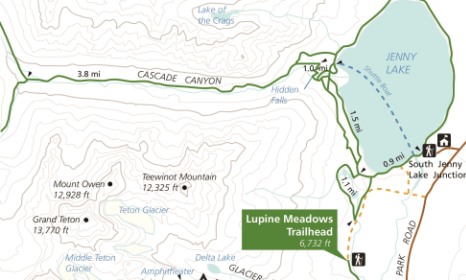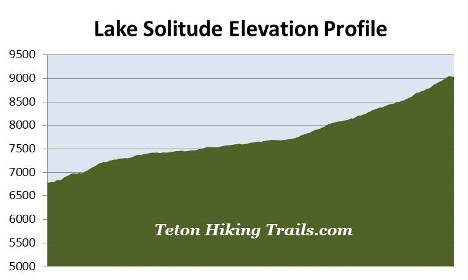
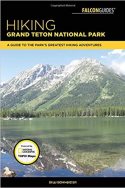
Lake Solitude
| Trail Features: | Outstanding Views, Lake, Wildflowers | 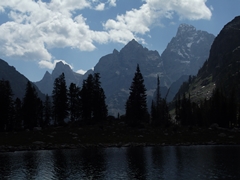 |
|||
| Trail Location: | Jenny Lake Trailhead | ||||
| Roundtrip Length: | 15.3 Miles | ||||
| Trailhead Elevation: | 6783 Feet | ||||
| Total Elevation Gain: | 2350 Feet | ||||
| Avg. Elev Gain / Mile: | 307 Feet | ||||
| Highest Elevation: | 9048 Feet | ||||
| Trail Difficulty Rating: | 20.00 (strenuous) | ||||
| Parking Lot Latitude | 43.75114 | ||||
| Parking Lot Longitude | -110.7238 | ||||
Trail Description:
The hike to Lake Solitude in Grand Teton National Park begins from the Jenny Lake Trailhead. To reach the trailhead turn west off Teton Park Road at the South Jenny Lake Junction, located roughly 7.7 miles north of Moose Junction. From the junction drive another half-mile to the boat dock parking area. Hikers will have the option of walking around the south end of Jenny Lake, or taking the shuttle boat across the lake to the Cascade Canyon Trailhead. The boat cuts-off roughly 2.4 miles of walking each way; however, there's a fee for the boat ride.
This hike description follows the route beginning from the Cascade Canyon Trailhead, located at the West Shore Boat Dock, after taking the 12-minute shuttle boat across Jenny Lake.
Covering roughly 1191 acres, glacially-carved Jenny Lake is the second largest lake in the Grand Tetons. At 423 feet it's also one of the deepest. The lake was named for a Shoshone Indian named Jenny who assisted with camp logistics during the Hayden Geological Survey of 1872. Nearby Leigh Lake is named for her husband, Richard "Beaver Dick" Leigh, an itinerant trapper and early tour guide who helped guide the Hayden Expedition through the area. In 1876 Jenny and their six children died of smallpox.
From the boat dock the trail begins climbing upward through a pristine conifer forest. It's likely you'll notice quite a few huckleberry patches along this stretch, which is one of the reasons why you'll need to watch for bears on this hike. Soon the trail crosses Cascade Canyon Creek, and at roughly three-tenths of a mile will reach the Valley Trail, which also serves as the western portion of the loop hike around Jenny Lake.
At just over a half-mile from the boat dock you'll pass the horse trail leading up from Jenny Lake. A short distance later you'll arrive at the side trail that leads to Hidden Falls. Hikers should turn left here to visit the viewing area of this impressive waterfall. Situated near the mouth of Cascade Canyon, Hidden Falls drops roughly two hundred feet in a series of steps.
After viewing the waterfall return back to the main trail and turn left to continue towards Inspiration Point. From the falls the trail resumes climbing along a very rocky and rugged footpath. As you near Inspiration Point you'll pass over a short section of trail that traverses a fairly steep ledge. This granite-carved segment of trail that gains access to Inspiration Point was built by Civilian Conservation Corps workers in the 1930s. Hikers should definitely use caution along this stretch.
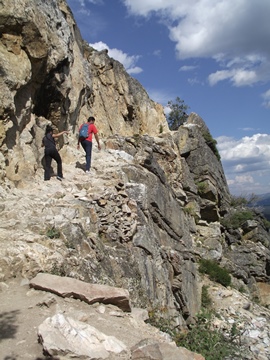
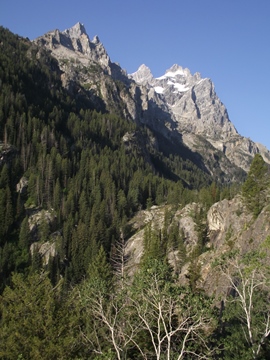
As you climb higher you'll enjoy outstanding views of the "Cathedral Group" towering above the canyon towards the west. This group of mountains includes 12,325-foot Teewinot Mountain, 13,770-foot Grand Teton and 12,928-foot Mt. Owen.
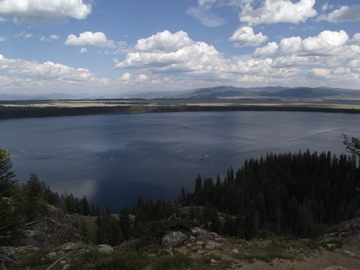 At 1.1 miles hikers will reach Inspiration Point, one of the most popular hiking destinations in the park. From this perch you'll enjoy commanding views of Jenny Lake, Jackson Hole, as well as the Gros Ventre Mountains towards the east.
At 1.1 miles hikers will reach Inspiration Point, one of the most popular hiking destinations in the park. From this perch you'll enjoy commanding views of Jenny Lake, Jackson Hole, as well as the Gros Ventre Mountains towards the east.
From this popular vantage point the trail continues towards the west. Soon you’ll enter the mouth of Cascade Canyon, and at almost 1.5 miles from the trailhead, will pass the north horse path junction. Hikers should proceed straight ahead here.
Over the course of the first couple of miles the trail passes through numerous huckleberry, thimbleberry and wild raspberry patches. While passing through these areas it's a good idea to make a lot of noise in case there are any bears around, especially near Cascade Canyon Creek where bears may not be able to hear your approach. While black bears are frequently seen in Cascade Canyon, grizzly bears are becoming more common. Therefore, it's a good idea to carry bear spray, make lots of noise, and travel in groups of three or more while on this trail.
As you proceed the canyon begins to narrow, and at roughly 1.9 miles you'll reach the first in a series of large boulder fields resting along the southern slopes of Storm Point. Keep an eye out for picas and marmots as you pass through these areas. Also keep an eye out for moose near the willow-choked creek on your left. The views of Mount Owen, the prominent mountain on the south side of the canyon, are absolutely stunning throughout this area. At 12,928 feet Mount Owen is the second highest mountain in Grand Teton National Park, and is named for William O. Owen, organizer of the first ascent of Grand Teton in 1898.
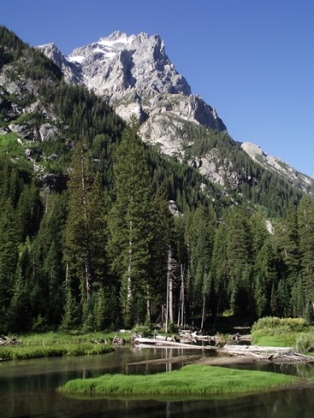 At roughly 2.6 miles you'll reach a series of ponds that make excellent foregrounds for the looming mountains above. As you proceed further up the canyon Table Mountain and The Wigwams will come into view towards the west. These two mountains form the western boundary of Cascade Canyon. As the trail proceeds even deeper into the canyon you'll also likely notice that it begins passing through areas that are considerably more forested.
At roughly 2.6 miles you'll reach a series of ponds that make excellent foregrounds for the looming mountains above. As you proceed further up the canyon Table Mountain and The Wigwams will come into view towards the west. These two mountains form the western boundary of Cascade Canyon. As the trail proceeds even deeper into the canyon you'll also likely notice that it begins passing through areas that are considerably more forested.
At 5 miles hikers will finally reach the Forks of Cascade Canyon. The trail to the left leads towards Hurricane Pass and Alaska Basin, while the trail to the right heads up the North Fork of Cascade Canyon, and eventually on to Lake Solitude.
From the junction the trail climbs through a dense evergreen forest, while mostly following along the North Fork of Cascade Creek. Before arriving at the first creek crossing, a little over a tenth-of-a-mile from the junction, look to your left and you may notice the old Cascade Canyon Patrol Cabin, which was built by the Civilian Conservation Corps in 1935. The structure was originally built as a barn, but after an avalanche destroyed the original patrol cabin in 1960, the barn was converted to a ranger patrol cabin. The building was rehabilitated in 2010, and is now listed on the National Register of Historical Places.
A little over a half-mile from The Forks the trail emerges into the open again. From this point forward, with the exception of a few small wooded sections, you'll be exposed to the sun. The trail also begins traversing over fairly rocky and rugged terrain as it makes its way up to the lake.
Hikers should note that this section of trail is usually at least partially snow-covered through June, and sometimes even into early July. However, once the snow melts, the surrounding meadows explode with a riot of wildflowers. Depending on the winter snowpack, wildflowers are usually at their best during the late July and early August time periods. Keep an eye out for Indian paintbrush, Columbia monkshood, columbines, bluebells, purple fringed gentians and yellow goldenrod, among many other varieties. Depending on your timing, you may also find a profusion of glacier lilies surrounding the lake.


As the trail climbs higher the canyon narrows. The trail also becomes progressively steeper, and becomes quite a slog over the last mile or so. Look back from time to time for some great views of Mt. Owen and Grand Teton as you proceed higher.
At roughly 7.5 miles the trail reaches the top of the glacial moraine that forms Lake Solitude. After walking another 100 yards or so look for a side trail that leads down to a rocky area on the lake. At almost 7.7 miles hikers will finally reach the end of a small rocky peninsula that juts into the lake. This is a great spot to relax and soak-in the grand views that make this one of the best hikes in Grand Teton National Park.
Lake Solitude is surrounded on almost three sides by a headwall that towers roughly 1500 feet above the water. However, looking towards the south, Teewinot Mountain, Mt. Owen and Grand Teton seemingly rise above the western shore of the glacially-carved lake. This vantage point allows hikers to see the actual difference in size among the three mountains, which rank as the first, second and sixth highest peaks in the park.
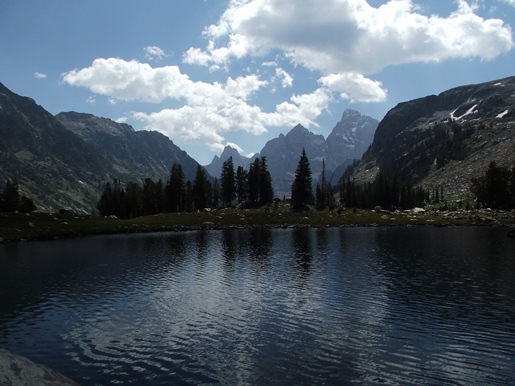
If you look towards the east you should be able to see the trail as it heads up and over Paintbrush Divide. From the pass the trail descends through Paintbrush Canyon to reach String Lake. Backpackers and long-distance day hikers can create an epic loop hike by taking this route to return back to the Jenny Lake area. This extremely long, but spectacular loop travels almost 20 miles.
Hikers should always be aware of lightning risk while hiking in the Grand Tetons, especially at higher elevations. As a general rule of thumb you should plan to turnaround before noon in order to avoid the notorious afternoon thunderstorms that frequent the mountains during the summer months. Hikers should also be prepared for extreme sun exposure, wind, cool temperatures, and rapidly changing weather conditions while on this hike. Make sure you have the proper gear with you, and know what safety precautions you need to consider beforehand.
